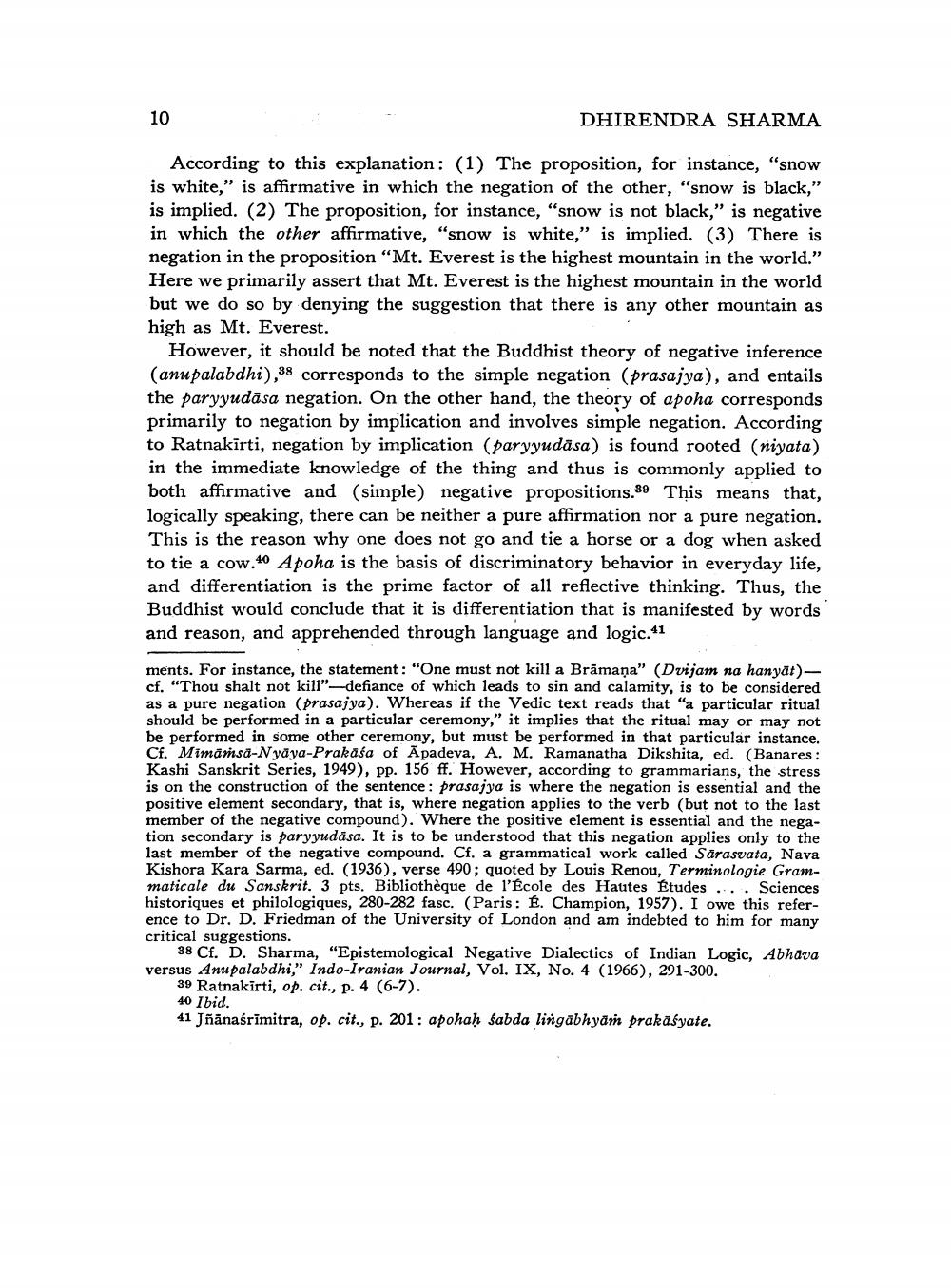________________ 10 DHIRENDRA SHARMA According to this explanation: (1) The proposition, for instance, "snow is white," is affirmative in which the negation of the other, "snow is black," is implied. (2) The proposition, for instance, "snow is not black," is negative in which the other affirmative, "snow is white," is implied. (3) There is negation in the proposition "Mt. Everest is the highest mountain in the world." Here we primarily assert that Mt. Everest is the highest mountain in the world but we do so by denying the suggestion that there is any other mountain as high as Mt. Everest. However, it should be noted that the Buddhist theory of negative inference (anupalabdhi),38 corresponds to the simple negation (prasajya), and entails the paryyudasa negation. On the other hand, the theory of apoha corresponds primarily to negation by implication and involves simple negation. According to Ratnakirti, negation by implication (paryyudasa) is found rooted (riyata) in the immediate knowledge of the thing and thus is commonly applied to both affirmative and (simple) negative propositions.39 This means that, logically speaking, there can be neither a pure affirmation nor a pure negation. This is the reason why one does not go and tie a horse or a dog when asked to tie a cow.40 Apoha is the basis of discriminatory behavior in everyday life, and differentiation is the prime factor of all reflective thinking. Thus, the Buddhist would conclude that it is differentiation that is manifested by words and reason, and apprehended through language and logic. 41 ments. For instance, the statement: "One must not kill a Bramana" (Dvijam na hanyat) -- cf. "Thou shalt not kill"-defiance of which leads to sin and calamity, is to be considered as a pure negation (prasajya). Whereas if the Vedic text reads that "a particular ritual should be performed in a particular ceremony," it implies that the ritual may or may not be performed in some other ceremony, but must be performed in that particular instance. Cf. Mimarsa-Nyaya-Prakasa of Apadeva, A. M. Ramanatha Dikshita, ed. (Banares: Kashi Sanskrit Series, 1949), pp. 156 ff. However, according to grammarians, the stress is on the construction of the sentence: prasajya is where the negation is essential and the positive element secondary, that is, where negation applies to the verb (but not to the last member of the negative compound). Where the positive element is essential and the negation secondary is paryyudasa. It is to be understood that this negation applies only to the last member of the negative compound. Cf. a grammatical work called Sarasvata, Nava Kishora Kara Sarma, ed. (1936), verse 490; quoted by Louis Renou, Terminologie Grammaticale du Sanskrit. 3 pts. Bibliotheque de l'Ecole des Hautes Etudes... Sciences historiques et philologiques, 280-282 fasc. (Paris : E. Champion, 1957). I owe this reference to Dr. D. Friedman of the University of London and am indebted to him for many critical suggestions. 38 Cf. D. Sharma, "Epistemological Negative Dialectics of Indian Logic, Abhava versus Anupalabdhi," Indo-Iranian Journal, Vol. IX, No. 4 (1966), 291-300. 39 Ratnakirti, op. cit., p. 4 (6-7). 40 Ibid. 41 Jnanasrimitra, op. cit., p. 01: apohah sabda lingabhyam prakasyate.




